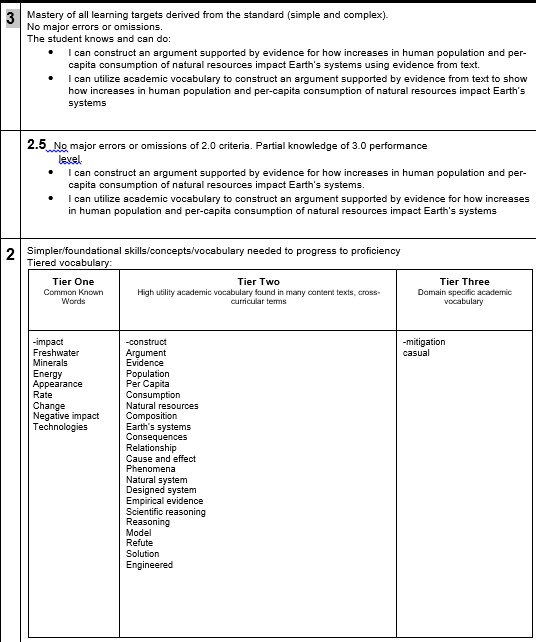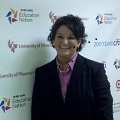Next Gen Navigator
NGSS: Planning for Science Success for All Students
By Hallie Booth
Posted on 2020-01-29
Creating an Environment for All Students to Show Their Understanding
Much discussion has focused on how the NGSS (and other state standards based on the Framework and NGSS) make science accessible to all students. I believe all students can be successful when lessons are designed to use the three dimensions to make sense of phenomena.
What Does an NGSS Classroom Look Like?
The NGSS classroom looks very different from the traditional classroom. Unlike past standards, the NGSS require students to develop ownership of the big ideas in science, not just memorize broad definitions with examples. Students are driving their own learning through the unit and creating artifacts demonstrating their in-depth understanding of the science ideas along the way. All of my units begin in the same way to ensure all of my students have equal-access sensemaking. I offer this glimpse into the thinking and intention of how I start each unit to ensure from the beginning that I am focused on how I can support and engage all students in my classroom:
- I create a storyboard—also referred to as a storyline—that establishes a learning progression for the unit. I consider the questions my unit-level phenomenon will elicit and design lessons that create opportunities for students to answer them.
- The unit begins with students experiencing the unit-level phenomenon. This might happen through pictures, data charts, and/or short videos. We create a class record of our observations.
- The students write their initial questions about the phenomenon that are formulated through a technique called Questioning Formulating Techniques (QFTs).
The questions students ask (and new questions that arise) drive the unit. We decide which question (or questions) we will try to answer, which leads us to the next lesson, and then the next question.
Intentionally Supporting Students
I find that all my students learn from one another through engaging with the science and engineering practices and having opportunities to demonstrate their understanding of the science ideas. As I analyze my class data, individual student demographics aren’t apparent: The data shows students who exceeded the “basic level” of the performance expectations, those who mastered them, and those (less than 10%) who need additional opportunities to engage in the practices to make sense of the targeted science ideas. I find student success is directly linked to the numerous opportunities they are given, opportunities that meet them at their current level of understanding and gradually bring them to an increase in rigor. This also allows students who have a greater understanding of the science ideas to begin higher and create related extensions. The students know where to begin by evaluating the self-guided proficiency chart.
Remediation is based on what my formative assessments tell me the students are struggling with most. In these mini-sessions, I ask specific questions about their artifacts or work on short, guided-learning tasks with them. After the mini-sessions, students tend to clarify any misunderstanding and indicate areas that need to be clarified. I will hold these additional sessions right before the summative assessment to answer any last-minute questions.
Teaching NGSS holds teachers more accountable for developing coherent storylines built around relevant phenomena and integrating the science and engineering practices and crosscutting concepts into each lesson or activity to support students while they are building their science knowledge. Through this process, I have been able to develop opportunities to individualize the learning experience and ascertain the level of mastery for each of my students. Since I started this, I have had tremendous feedback from several students in all demographics:
- “Now I really have to think and process the information.”
- “I do not have to just tell you definitions; I have to connect them to the given task.”
- “I like doing science like this because it really helps me understand what they are asking me.”
- “I feel like I can discuss the information in class, and [if I don’t understand something,] I feel like I [can] ask questions about it and not be [labeled as] ‘different’ because a lot of students ask questions in the discussion.”
As teachers, we want all students to be successful, so it is up to us to create a classroom environment that allows this to happen. It is up to us to design units/lessons that make it clear what students are trying to figure out, that are relevant and engaging to students, and that are scaffolded in a manner that helps every kid feel supported. When we have students who are not successful, we have to look inward and ask what we can do differently to enable their success.


Students’ resources

 Hallie Booth has spent 25 years in education, serving as an instructional specialist, assistant principal, principal, and the Kentucky Department of Education Regional Science Lead. She currently teaches eighth-grade science at Ballyshannon Middle School in Boone County, Kentucky. Booth holds a Bachelor of Arts (BA) degree in Criminal Justice Law Enforcement, a BA in Elementary Education, a masters in special education, an endorsement in K–9 science education, and a Rank 1 in leadership. She has served as a Common Core fellow, an Education Nation panelist, a Literacy Design Collaborative trainer, an education consultant for the Southern Regional Education Board, and a Thurgood Marshall Foundation trainer. Contact her via Twitter: @alwaysreach1.
Hallie Booth has spent 25 years in education, serving as an instructional specialist, assistant principal, principal, and the Kentucky Department of Education Regional Science Lead. She currently teaches eighth-grade science at Ballyshannon Middle School in Boone County, Kentucky. Booth holds a Bachelor of Arts (BA) degree in Criminal Justice Law Enforcement, a BA in Elementary Education, a masters in special education, an endorsement in K–9 science education, and a Rank 1 in leadership. She has served as a Common Core fellow, an Education Nation panelist, a Literacy Design Collaborative trainer, an education consultant for the Southern Regional Education Board, and a Thurgood Marshall Foundation trainer. Contact her via Twitter: @alwaysreach1.
Note: This article is featured in the January 2020 issue of Next Gen Navigator, a monthly e-newsletter from NSTA delivering information, insights, resources, and professional learning opportunities for science educators by science educators on the Next Generation Science Standards and three-dimensional instruction. Click here to sign up to receive the Navigator every month.
The mission of NSTA is to promote excellence and innovation in science teaching and learning for all.
Disclaimer: The views expressed in this blog post are those of the author(s) and do not necessarily reflect the official position of the National Science Teaching Association (NSTA).
Assessment Equity NGSS Phenomena Science and Engineering Practices Teaching Strategies Three-Dimensional Learning Middle School Elementary High School


